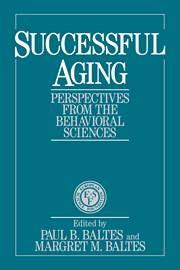Book contents
- Frontmatter
- Contents
- List of contributors
- Foreword
- Preface
- 1 Psychological perspectives on successful aging: The model of selective optimization with compensation
- 2 Medical perspectives upon successful aging
- 3 Successful aging in a post-retired society
- 4 The optimization of cognitive functioning in old age: Predictions based on cohort-sequential and longitudinal data
- 5 The optimization of episodic remembering in old age
- 6 Peak performance and age: An examination of peak performance in sports
- 7 Personal control over development and quality of life perspectives in adulthood
- 8 Successful mastery of bereavement and widowhood: A life-course perspective
- 9 The Bonn Longitudinal Study of Aging: Coping, life adjustment, and life satisfaction
- 10 Risk and protective factors in the transition to young adulthood
- 11 Avoiding negative life outcomes: Evidence from a forty-five year study
- 12 Developmental behavioral genetics and successful aging
- Name index
- Subject index
8 - Successful mastery of bereavement and widowhood: A life-course perspective
Published online by Cambridge University Press: 22 March 2010
- Frontmatter
- Contents
- List of contributors
- Foreword
- Preface
- 1 Psychological perspectives on successful aging: The model of selective optimization with compensation
- 2 Medical perspectives upon successful aging
- 3 Successful aging in a post-retired society
- 4 The optimization of cognitive functioning in old age: Predictions based on cohort-sequential and longitudinal data
- 5 The optimization of episodic remembering in old age
- 6 Peak performance and age: An examination of peak performance in sports
- 7 Personal control over development and quality of life perspectives in adulthood
- 8 Successful mastery of bereavement and widowhood: A life-course perspective
- 9 The Bonn Longitudinal Study of Aging: Coping, life adjustment, and life satisfaction
- 10 Risk and protective factors in the transition to young adulthood
- 11 Avoiding negative life outcomes: Evidence from a forty-five year study
- 12 Developmental behavioral genetics and successful aging
- Name index
- Subject index
Summary
Introduction
Because increasing age is typically accompanied by the loss of important social relationships, the study of coping with loss is particularly relevant for understanding successful aging. Moreover, loss of a spouse is generally considered to be one of the most serious threats to health, well-being, and productivity during the middle and later years (see Clayton, 1979; Osterweis, Solomon, & Green, 1984; M. Stroebe & W. Stroebe, 1983; W. Stroebe & M. Stroebe, 1987; and Vachon, 1976, for reviews). In the United States alone, approximately 800,000 people are widowed each year (Osterweis et al., 1984). In fact, there are presently more than 10 million widows and 3 million widowers in the United States, and the number of bereaved continues to increase (Ball, 1976–1977). The period of widowhood is often lengthy, particularly for women. Only one quarter of widows remarry within 5 years of the loss of their spouse, and the average woman remains widowed for the rest of her life, typically about 19.5 years (Carter & Glick, 1976).
Successful mastery of this major transition is an important feature of the aging experience. The marital pair may have such closely interwoven lives that the loss of one partner may cut across the very meaning of the other's existence (Raphael, 1983). Widowhood is associated with higher mortality for both sexes, although the excess risk is much greater for men, especially during the first 6 months of bereavement (M. Stroebe & W. Stroebe, 1983; W. Stroebe & M. Stroebe, 1987).
- Type
- Chapter
- Information
- Successful AgingPerspectives from the Behavioral Sciences, pp. 225 - 264Publisher: Cambridge University PressPrint publication year: 1990
- 29
- Cited by



